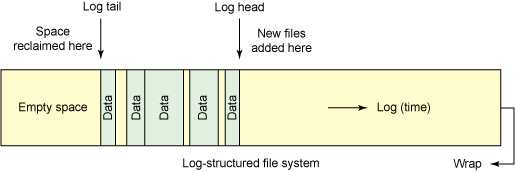What data recovery tools to buy if you want to start a data recovery business?
Free video data recovery training on how to recover lost data from different hard drives?
Where to buy head and platter replacement tools at good prices?
Data recover case studies step by step guide
I want to attend professional data recovery training courses
Log-structured file systems have a rich history in modern computing systems. The first log-structured file system was proposed by John Ousterhout and Fred Douglis in 1988 and subsequently implemented in the Sprite operating system in 1992. As the name implies, a log-structured file system views the file system as a circular log in which new data and file system metadata are written to the head of the log, and free space is reclaimed from the tail (see Figure 1). This means that data may appear two or more times in the log, but as the log is chronologically advancing, the most recent data is viewed as the active data. Having multiple copies of data in the log introduces some interesting benefits, which will be covered in more detail below.
Simple view of a log-structured file system

Although the log-structured approach is an architectural detail more than a selling point, the approach does offer some distinct advantages. One key advantage is recovery from system crashes, which is simpler using the log-structured approach.
Another advantage is the use of the underlying storage system to exploit performance. You might recall that writing to disks sequentially is much faster than random I/O. As all writes occur sequentially, the seek tax is diminished, resulting in faster disk I/O and subsequently a faster file system.
Log-structured file systems and SSDs
Log-structured file systems are an ideal format for solid-state disks (SSDs), which are made up of NAND flash. The fundamental problem with flash is that it has a limited number of write and erase cycles. Because the log writes over the entire device, it levels the writes over the device and thus minimizes erase cycles. For this reason, log-structured file systems perform very well on SSDs (sequential writes) and also provide better wear-leveling.
Read more here: https://www.ibm.com/developerworks/linux/library/l-nilfs-exofs/







Comments are closed
Sorry, but you cannot leave a comment for this post.